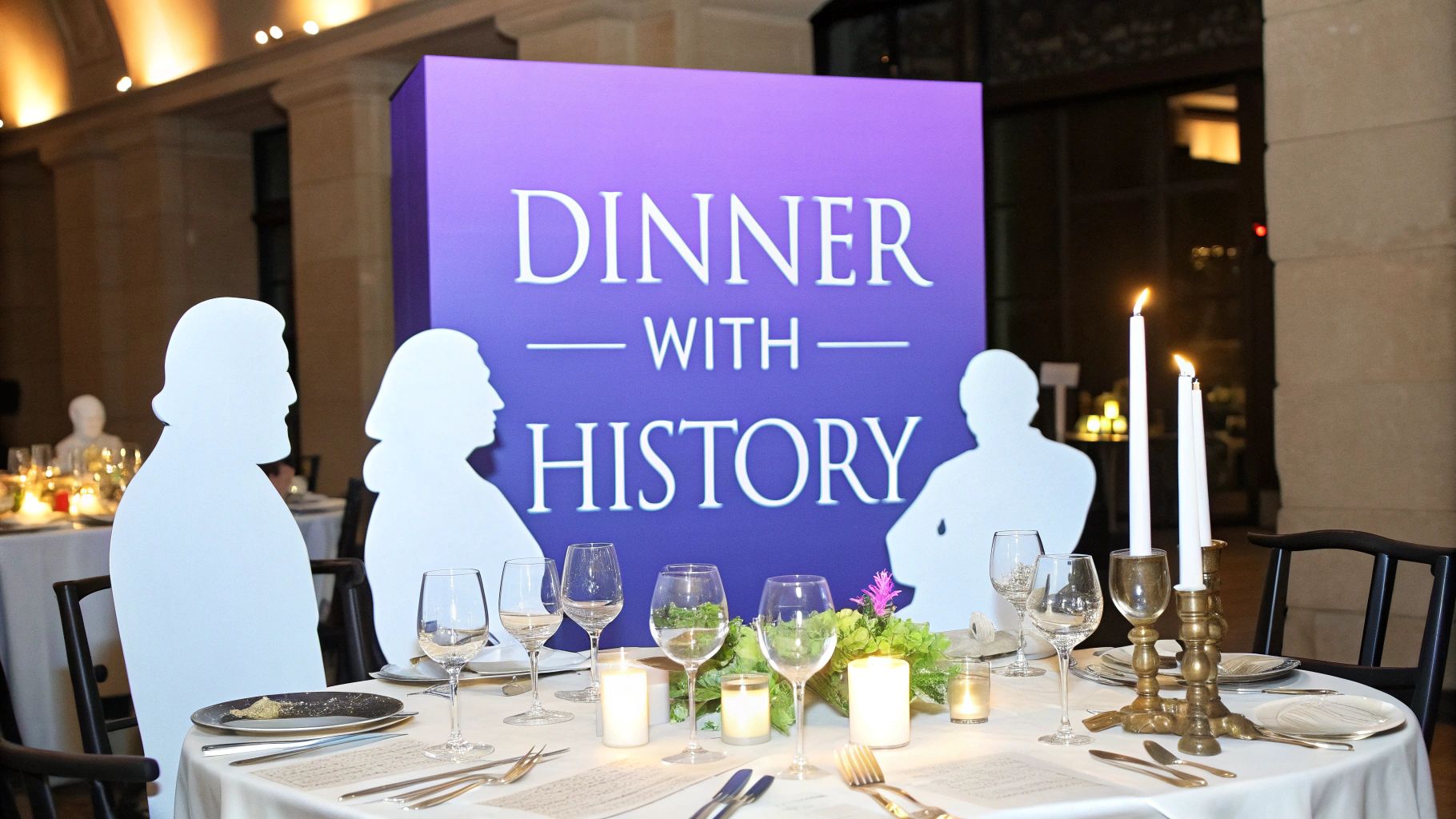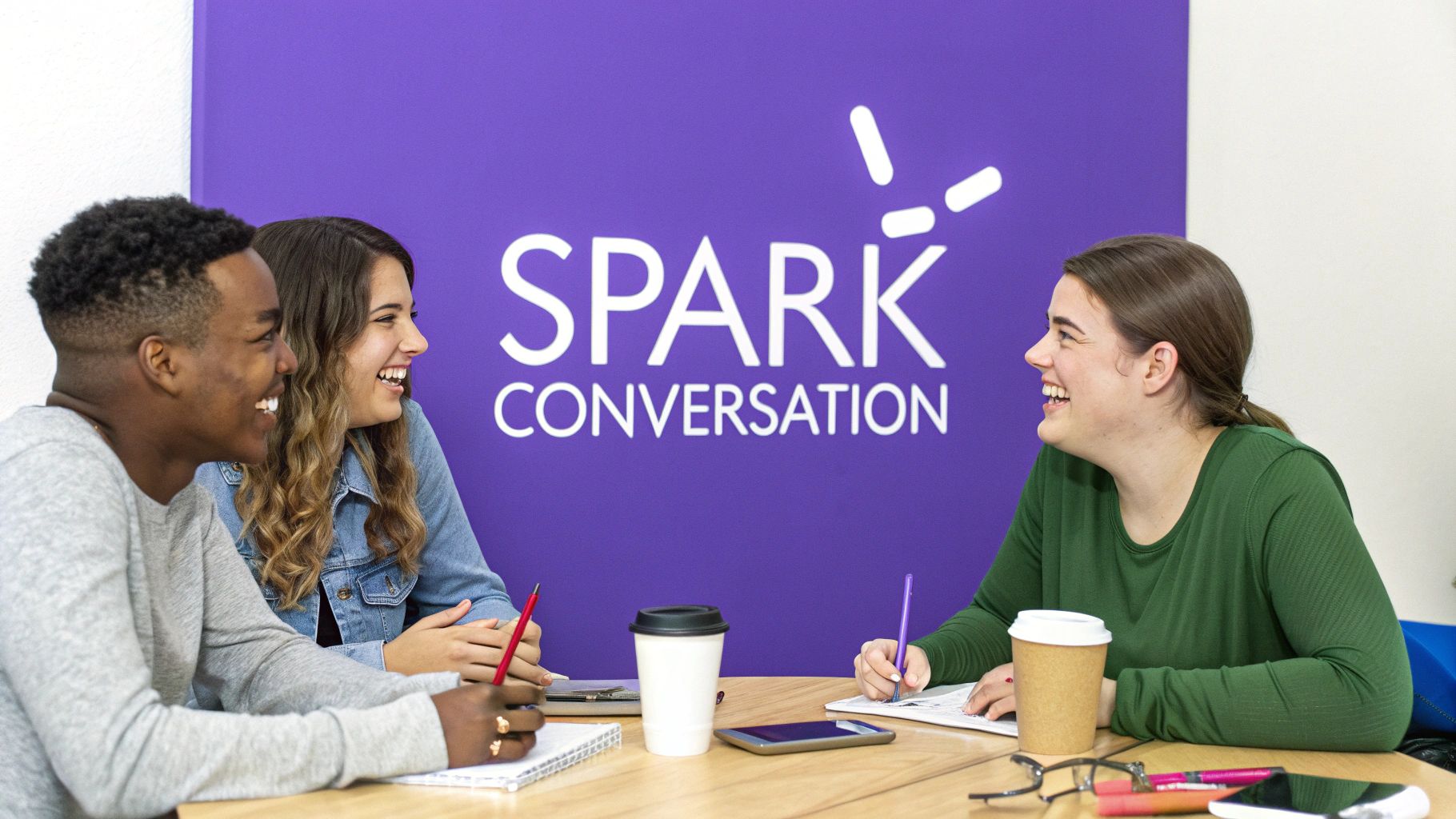Breaking the Ice: Jumpstarting Engaging Conversations
Strong communication is essential for modern teams, but building authentic connections in a virtual environment isn’t always easy. Those casual chats that used to happen naturally by the coffee machine or in hallways are now replaced by scheduled video calls and messaging. Starting meaningful conversations with teammates, especially new ones, can feel a bit forced or awkward at times.
Icebreakers have come a long way from their origins as formal meeting warmups. Today, they serve as practical tools for helping teams connect and collaborate better in remote settings. A well-crafted icebreaker does more than fill awkward silences – it creates space for people to share perspectives, discover common ground, and engage in genuine dialogue. The key is choosing questions that make everyone feel comfortable participating while sparking real conversation.
In this guide, we’ll share a selection of thoughtful icebreaker questions designed specifically for remote teams, tech companies, and startups. These questions will help your team move past surface-level small talk to build stronger relationships and create a more connected culture. Whether you’re onboarding new hires, hosting virtual team events, or just looking to energize your daily standups, you’ll find fresh ideas to get people talking and interacting naturally.
1. If you could have any superpower, what would it be and why?

This fun icebreaker question helps remote teams learn about each other in a casual, engaging way. It’s especially effective for tech teams where creative thinking is important. By sharing their dream superpower and explaining why they chose it, team members reveal aspects of their personality, values and goals.
Key Benefits
The question is wonderfully open-ended and sparks interesting conversations. Someone might pick teleportation to avoid commuting (showing they value efficiency), while another chooses mind-reading to better understand clients (highlighting their focus on communication). These choices give helpful insights about team members, which is extra valuable in remote settings.
Real Examples
Picture a new remote dev team using this during their first video call. One person might want super-speed coding powers to finish projects faster, showing their drive for productivity. Another might wish to instantly master any programming language, revealing their passion for learning. These discussions naturally highlight shared interests and potential collaboration opportunities.
Why It Works
This icebreaker has stood the test of time because it works for everyone, regardless of age or background. It’s equally effective in casual chats and formal team introductions. The simplicity makes it easy to use in any setting.
Tips for Remote Teams
- Ask follow-ups: Go beyond the initial answer with questions like “How would you use that power in your daily work?” or “How could that ability help the team?”
- Lead by example: Share your own superpower choice first to encourage others to participate
- Use in groups: Works great in team video calls to spark discussion and find common ground
- Make it relevant: For tech teams, ask how they’d use their power to improve products or solve technical problems
Key Features:
- Gets people thinking creatively
- Shows what people value
- Fun and engaging
- Works for all groups
Advantages:
- Simple to understand
- Creates good conversations
- Helps find shared interests
- Easy conversation starter
Challenges:
- Answers can be repetitive (use targeted follow-ups)
- May feel overused (less common in casual remote settings)
2. What’s the most interesting place you’ve ever visited?

This simple but engaging question helps remote teams connect on a deeper level. By sharing travel stories, team members can learn about each other’s experiences, interests and perspectives in a natural way.
For remote teams who rarely meet in person, understanding colleagues as individuals is key for building strong working relationships. Discussing travel adventures creates common ground and sparks conversations that go beyond day-to-day work tasks.
What makes this question work:
The question invites people to share meaningful personal experiences rather than just surface-level small talk. It reveals what fascinates and inspires different team members.
Key benefits:
- Authentic sharing: People can draw from real experiences they’re excited to talk about
- Cultural learning: Team members gain appreciation for different places and ways of life
- Natural storytelling: Travel tales help people express their personality and communication style
- Visual engagement: Descriptions of interesting places spark imagination and shared discovery
Why it’s great for teams:
- Easy participation: Everyone has visited somewhere they found fascinating
- Leads to deeper discussions: Follow-up questions flow naturally about food, culture, surprises
- Shows what interests people: Reveals how different team members approach exploring the world
- Builds understanding: Exposes the team to diverse perspectives and experiences
How to use it effectively:
- During virtual team socials to spark engaging group conversations
- In cultural exchange activities to celebrate team diversity
- As an icebreaker for industry networking events
Tips for great discussions:
- Ask about specific memorable moments and unexpected discoveries
- Encourage sharing about local customs, food and traditions
- Connect responses to broader topics like sustainable travel or emerging destinations
This question helps remote teams build real connections by sharing travel experiences. The discussions reveal shared interests while fostering appreciation for the different perspectives that make teams stronger.
3. What’s the Best Piece of Advice You’ve Ever Received?
This powerful icebreaker question helps remote team members share meaningful life lessons and core values. By asking about impactful advice they’ve gotten, you open the door for authentic conversations that reveal what guides and motivates your colleagues.
For remote teams, especially in fast-paced startups, understanding your teammates’ principles and experiences builds trust and stronger working relationships. When people share personal stories and wisdom, it creates real human connections despite physical distance.
Features and Benefits:
- Knowledge Exchange: Team members learn from each other’s key life experiences
- Value Discovery: Gain insight into what matters most to colleagues
- Deeper Bonds: Start meaningful conversations beyond work topics
- Personal Growth: Reflect on advice that shaped your path
Pros:
- Rich Discussions: Gets more thoughtful responses than basic icebreakers
- Fresh Perspectives: Reveals teammates’ unique viewpoints and strengths
- Memorable Sharing: Personal stories stick with people
- Universal Appeal: Works well across different cultures and backgrounds
Cons:
- Processing Time: Some need a moment to identify their most valuable advice
- Personal Nature: Topics could be sensitive – make sharing optional and respect boundaries
Ways to Use It:
- Mentoring: Helps mentors share key lessons with mentees
- Career Growth: Sparks discussions about professional development
- Leadership Training: Explore how experiences shape leadership styles
Tips for Remote Teams:
- Give Think Time: Share the question beforehand or allow reflection breaks
- Add Context: Ask people to explain when/where they got the advice
- Go Deeper: Follow up on how the advice changed their approach
This icebreaker works because it creates genuine understanding between remote teammates. For distributed teams who can’t connect in person, sharing meaningful advice and stories helps build the strong relationships needed for great collaboration.
4. What would you do if you won the lottery tomorrow?

This question remains one of the most effective ways to help remote team members get to know each other better. It sparks fun conversations while revealing insights into people’s values and dreams. When someone shares what they’d do with a sudden windfall – whether investing, traveling, buying a home, or paying off debt – their answer tells us about their priorities and personality.
The appeal of this icebreaker lies in its universal nature. Most people have imagined winning big, making it an easy topic to discuss. For remote teams who miss out on casual office chats, this question creates natural opportunities to connect and share personal aspirations.
Key Benefits:
- Shows money mindset: Learn if teammates are natural savers, risk-takers, or big spenders
- Reveals core values: See what matters most – family, experiences, giving back, or self-growth
- Builds trust: Creates a safe space for sharing hopes and dreams
- Highlights thinking style: Note if responses are practical or imaginative
What Makes It Work:
- Easy for everyone to relate to
- Brings out personality traits
- Gets people talking openly
- Keeps things light and fun
This question works especially well because it balances fun with meaningful discussion. It’s casual enough that people feel comfortable sharing, yet their answers often provide genuine insights that help remote teams bond. For technical teams used to analytical thinking, it encourages creative “what if” discussions.
Tips for Remote Teams:
- Compare scenarios: Ask about different amounts like $1M vs $100M to see how priorities shift
- Discuss giving: Ask about charitable plans to understand social values
- Balance practicality: Encourage both realistic and dream responses to see full perspective
When used thoughtfully, this icebreaker helps remote teams develop stronger connections by understanding each other’s goals and motivations. The shared experience of imagining good fortune creates positive energy that teams can channel into their work together.
5. What’s your most unusual talent or skill?
This question helps remote teams discover interesting aspects of their coworkers beyond their work roles. It creates genuine connections as team members share unique abilities and hidden passions. By focusing on unusual skills rather than typical ones, everyone has something distinctive to contribute.
Why it works for remote teams:
Technical teams often focus solely on work skills. This question adds a personal touch by spotlighting individual quirks and interests. When team members discover shared hobbies or appreciate each other’s unique abilities, it builds authentic connections that improve how they work together.
Features and Benefits:
- Shows Personality: Goes beyond job titles to reveal who people really are
- Makes Lasting Impressions: Unique talents stick in people’s minds and make great conversation starters
- Opens Up Sharing: Creates a comfortable space for team members to share personal details
- Adds Fun: Many unusual skills are entertaining to learn about or watch in action
Pros & Cons:
- Pros: Memorable stories, reveals hidden sides of people, often leads to fun demonstrations
- Cons: Some may feel they don’t have special talents (remind them that any unique interest counts), could make some feel pressured (emphasize that sharing is optional)
Real Examples:
Picture a developer revealing they can juggle while coding, or an analyst showing off expert yodeling skills. These personal glimpses help teams connect. One company used this question and found two team members who loved competitive origami. They started a dedicated Slack channel for it, creating a mini-community within the team.
Tips for Using This Question:
- Welcome all answers: A goofy talent is just as valuable as a serious skill
- Invite demonstrations: Screen sharing makes it easy to show talents virtually
- Go first: Share your own unusual ability to set others at ease
- Keep it positive: Frame it as “something you can do that most people can’t” rather than focusing on how unusual it is
History and Growth:
While talent sharing isn’t new, this specific question has become more popular as remote work grows. Virtual teams need creative ways to build personal connections, and this question fills that need perfectly.
By asking about unusual talents and skills, you’ll learn fascinating things about your teammates, build stronger bonds, and make remote work more engaging and fun.
6. If you could have dinner with any historical figure, who would it be and why?

This question goes beyond basic introductions and taps into what truly interests and inspires people. For remote teams, especially in tech companies, it creates deeper connections than just talking about work tasks and deadlines. When someone shares their choice of historical dinner guest, you learn about their heroes, values, and thought process.
Often used in college interviews and educational settings, this question evaluates both knowledge of history and ability to draw meaningful connections. For remote teams, it reveals how teammates think through problems and view the bigger picture.
Why this question works well:
It’s not just a fun exercise – it sparks discussions about history, encourages sharing different viewpoints, and uncovers intellectual interests. This is especially useful for remote tech teams that need diverse perspectives to solve problems.
Key Benefits:
- Learning Opportunity: Gets people thinking about historical events and figures
- Historical Context: Shows how past events connect to present situations
- Personal Insights: Reveals interests and expertise beyond technical skills
- Team Building: Creates engaging conversations that help teams bond
Tips for Using This Question:
- Ask people to explain their choice in detail – what specific questions would they ask?
- Connect historical situations to modern work challenges
- Discuss how the figure’s ideas apply to current issues
- Keep the tone casual and fun – it’s still an icebreaker!
Real Example:
If someone picks Ada Lovelace, it can lead to great discussions about early computing history, women in tech, and the impact of AI – all relevant topics for today’s tech teams.
This question helps remote teams move past small talk to build real connections. It creates space for meaningful conversations that strengthen relationships and may even spark new ideas and solutions.
7. What’s the most adventurous thing you’ve ever eaten?
This lively question helps teams connect by sharing their memorable food experiences. Food is something everyone can relate to, and asking about unusual dishes often leads to engaging stories that reveal aspects of people’s personalities. For remote tech teams, understanding how colleagues approach new experiences provides valuable insight into their adaptability and openness to change.
Why it works for remote teams: Building connections can be challenging when working remotely. Discussing unique food experiences creates natural conversation and shared understanding across geographical distances. Since food plays a central role in cultures worldwide, these discussions help bridge physical gaps between team members.
Key Benefits:
- Cultural Learning: Stories about trying foods like balut (developing bird embryo) from the Philippines or hákarl (fermented shark) from Iceland offer windows into different cultures
- Natural Conversation: Food discussions flow easily into chats about cooking, recipes and favorite meals
- Personal Stories: Food experiences often come with memorable stories that stick with people
- Fun Factor: Tales of surprising flavors or food mishaps bring laughter and good energy to the group
Examples from Real Teams:
- A new team member shares their first time trying durian fruit, sparking a lively discussion about strong-smelling foods
- Two colleagues bond over their love of spicy dishes after one describes an intense vindaloo curry experience
- A team member’s story about accidentally ordering live octopus in South Korea gets everyone sharing similar food adventures
Tips for Using This Question:
- Ask follow-up questions like “What made you try it?” and “Where were you?”
- Explore the cultural meaning behind unique dishes that come up
- Share your own adventurous food story to encourage openness
Benefits:
- Everyone can participate
- Creates memorable discussions
- Highlights cultural experiences
- Easy to connect with
Note: Be mindful that some people may have limited experience with unusual foods or dietary restrictions. Keep the conversation inclusive and pressure-free.
This question works so well because it naturally combines food, culture and storytelling to help remote teams connect. It’s approachable, relatable and opens doors for teammates to better understand and appreciate their differences.
8. What was your childhood dream job?
This simple question sparks personal memories and insights. Perfect for remote teams, it explores early ambitions and growth – often with a dash of humor.
Why it works for remote teams: In a virtual environment, making personal connections takes extra effort. This question helps team members relate on a human level by sharing childhood hopes and aspirations. It’s much more meaningful than typical small talk.
Features:
- Memory-based: Brings back fond childhood recollections
- Career focused: Opens natural discussions about professional paths
- Shows growth: Demonstrates personal development over time
- Adds fun: Childhood dreams can be amusingly unrealistic
Benefits:
- Easy to answer: Most people quickly recall their childhood career dreams
- Reveals journey: Shows how life experiences shape career choices
- Builds bonds: Often uncovers shared childhood aspirations
- Sparks stories: The gap between childhood dreams and reality leads to engaging tales
Examples in Practice:
- Career discussions: Use in team workshops to explore motivations and future goals
- Virtual networking: Quick way to create memorable connections in online events
- Mentoring: Helps mentors understand early influences on career choices
Tips for Implementation:
- Link past and present: Ask how current roles connect to childhood dreams
- Explore influences: Discuss what inspired the early career goals
- Track changes: Talk about how and why career aspirations evolved
Conversation Starters:
- “Anyone want to be an astronaut growing up? Still planning that space trip?”
- “I dreamed of being a vet until I found out I was allergic to cats! What about you?”
- “Let’s hear those childhood career dreams – I bet we have some good stories!”
This simple icebreaker helps remote teams build stronger bonds and discover shared interests beyond work. It creates natural opportunities for authentic connection through shared stories.
9. What’s the best gift you’ve ever given or received?
This question helps teams share meaningful stories and build real connections by focusing on memorable gifts that made a lasting impact. It looks at gifts from both sides – giving and receiving – and often reveals what people truly value beyond just material things. When used with remote teams, it creates space for personal stories that might not come up during regular work conversations.
Why it works for remote teams:
For teams working remotely in tech and startups, building genuine relationships is key to working well together. This question helps by:
- Creating Personal Stories: When people share their gift experiences, it brings out emotions and builds trust, helping remote teams feel more connected
- Showing What Matters: The gifts people choose as their “best” often show what they really care about – whether it’s creativity, practicality, or sentimental value
- Highlighting Kindness: The stories behind gifts often demonstrate thoughtfulness and care, which are essential for remote teams where clear communication matters
- Making Connections: Even though team members may never have met in person, sharing these stories helps them find common ground
Real examples:
- A developer shares that his best gift was a handwritten note from his mentor after finishing a tough project, showing how much he values recognition and guidance
- During a team holiday call, someone talks about sending a care package to a colleague going through a hard time, showing how team support matters
Tips for using this question:
- Ask about the story behind the gift rather than what it cost
- Have people explain why the gift meant so much to them
- Talk about how the gift affected their relationship with the giver/receiver
Best times to use it:
- Holiday team gatherings
- Virtual coffee chats
- Team bonding sessions
- Welcome meetings for new team members
Benefits:
- Builds emotional connections
- Shows personal values
- Demonstrates thoughtfulness
- Creates team bonds
Things to watch for:
- Be mindful of economic differences (focus on meaning over money)
- Some gift memories might be sensitive (keep the tone positive)
This question works because it taps into universal experiences of giving and receiving while helping remote teams develop stronger personal bonds. The shared stories create lasting connections that improve how people work together.
10. What Three Items Would You Bring to a Deserted Island?
If you were stranded on a deserted island and could only bring three items, what would you choose? This memorable icebreaker reveals how people think through challenges and set priorities. Beyond just being a fun hypothetical, it offers insights into problem-solving approaches and decision-making styles.
For remote teams, this question helps uncover how colleagues tackle problems and make choices. Some may focus on pure survival needs, while others think about comfort or rescue. These different approaches give teams valuable perspective on each other’s thinking.
Key Elements:
- Problem Analysis: Forces people to identify core survival needs
- Decision Making: Requires weighing tradeoffs between different items
- Creative Thinking: Limited choices push people to find clever solutions
- Values: Reveals what matters most to people under pressure
Benefits:
- Gets people actively thinking and discussing
- Shows different approaches to challenges
- Creates natural conversation flow
Potential Drawbacks:
- Can become repetitive if used often
- May get common responses
Real World Example:
During a recent remote team onboarding, this icebreaker helped new hires connect with existing team members. The practical thinker who chose water filtration found common ground with the engineering team. Meanwhile, someone suggesting a satellite phone sparked talks about innovation with product developers.
Background:
This question gained popularity through shows like “Survivor” and survival-focused programs. Team facilitators adopted it to understand group dynamics and individual problem-solving styles.
Tips for Remote Teams:
- Add Context: Specify details like “You’re on a tropical island with dense jungle” to make scenarios more engaging
- Ask Why: Have people explain their choices to deepen discussions
- Go Further: Explore how people would use items together and create survival plans
This simple but powerful question reveals how people think through challenges while building team connections in an engaging way.
10-Point Icebreaker Comparison Guide
| Question | 🔄 Complexity & Tips | ⚡ Resources & Use Cases | 📊 Outcomes | ⭐ Key Advantages |
|---|---|---|---|---|
| If you could have any superpower, what would it be and why? | Low complexity; prompt follow-up on power usage | Minimal resources; ideal for team building, class introductions, and networking | Reveals personality traits and values; sparks creative dialogue | Easy to understand, engaging, and fun |
| What’s the most interesting place you’ve ever visited? | Low complexity; encourage detailed cultural descriptions | Leverages personal travel experience; suited for social and cultural gatherings | Promotes storytelling while enhancing cultural awareness | Draws on real experiences for vivid conversation |
| What’s the best piece of advice you’ve ever received? | Moderate complexity; allow time for reflection and context sharing | Minimal resources; best in mentorship and development settings | Generates thoughtful responses and meaningful connections | Provides valuable insights across diverse cultures |
| What would you do if you won the lottery tomorrow? | Low complexity; use prompts about specific amounts or choices | Scenario-based; perfect for financial workshops and social mixers | Reveals dreams, priorities, and decision-making processes | Universally engaging and lighthearted discussion starter |
| What’s your most unusual talent or skill? | Moderate complexity; may invite both serious and humorous answers | May require live demonstration; excellent for team introductions and talent showcases | Uncovers hidden dimensions and personal individuality | Creates memorable, engaging stories that entertain |
| If you could have dinner with any historical figure, who would it be and why? | Moderate complexity; blend historical context with personal interests | Benefits from background knowledge; popular in interviews and educational settings | Sparks intellectual curiosity and enriching conversational insights | Combines personal values with historical perspective |
| What’s the most adventurous thing you’ve ever eaten? | Low complexity; encourage discussion of cultural context and personal experience | Relies on culinary experiences; ideal for food events, cultural exchanges, and travel discussions | Inspires vivid storytelling and highlights risk-taking tendencies | Relatable topic that is often humorous and engaging |
| What was your childhood dream job? | Low complexity; fosters nostalgia and easy reflection on early aspirations | Minimal resources; suited for career development and mentoring sessions | Reveals personal evolution and growth over time | Builds common ground and entertains through nostalgic recall |
| What’s the best gift you’ve ever given or received? | Moderate complexity; sensitive topics may need gentle probing | Focuses on relationship dynamics; works well for holiday gatherings, family events, and team building | Demonstrates thoughtfulness and emotional connection | Evokes personal values through meaningful gift-giving experiences |
| What three items would you bring to a deserted island? | Moderate complexity; challenge with scenario-based decision-making and strategy discussion | Demands critical thinking; best for team building, problem-solving workshops, and leadership training | Highlights strategic approaches, priorities, and debate opportunities | Encourages creative, practical thinking with engaging debates |
Keep the Conversation Going
Real connection starts with great questions, but the magic happens in the follow-up. When someone talks about their passion for travel after sharing their dream vacation spot, dig deeper! Ask about their top destinations or what adventures they’re planning next. The key is showing genuine interest in getting to know your teammates better.
Pay attention to what energizes your specific group. Some teams light up discussing superhero powers, while others prefer exploring thought-provoking topics like influential historical figures or life lessons learned. There’s no one-size-fits-all approach – adapt your questions based on what sparks the best discussions and helps everyone feel included.
Remote team building continues to grow and change. Many teams now use interactive activities and games to create shared experiences, even across screens. When everyone participates in solving challenges together, it builds authentic connections.
Key Takeaways:
- Be Curious: Ask thoughtful follow-up questions and show genuine interest
- Be Adaptive: Adjust your approach based on what works for your team
- Be Present: Listen actively and engage with others’ responses
Want to take your remote team’s brainstorming and bonding to new heights? Bulby helps remote teams collaborate effectively through structured brainstorming sessions. The platform ensures everyone’s ideas are heard while overcoming common creative blocks. Move beyond basic icebreakers and start building the meaningful connections that drive innovation. Check out Bulby to transform how your team works together.

